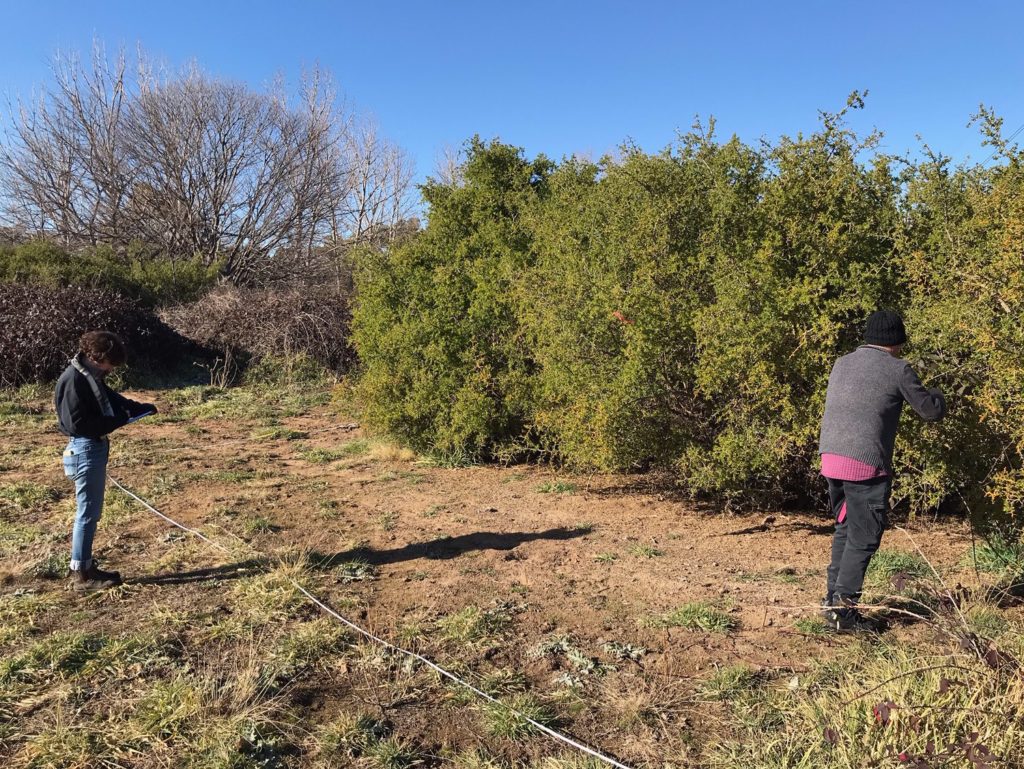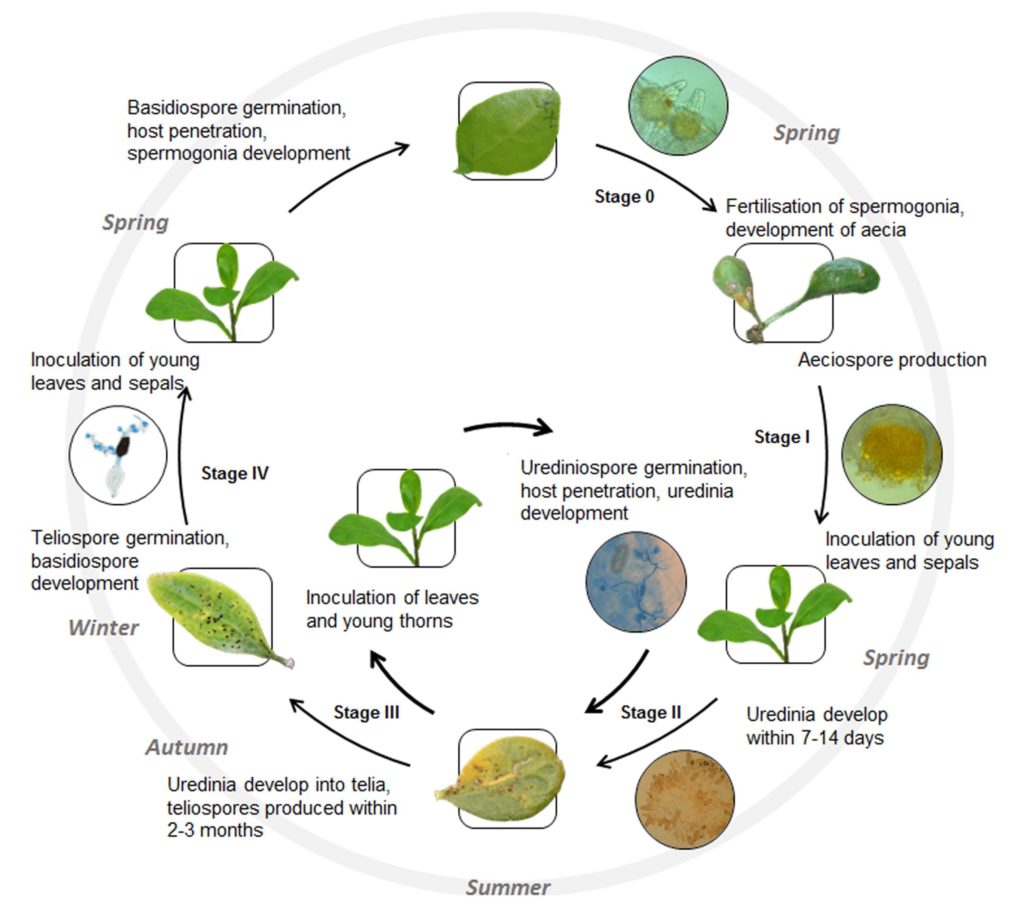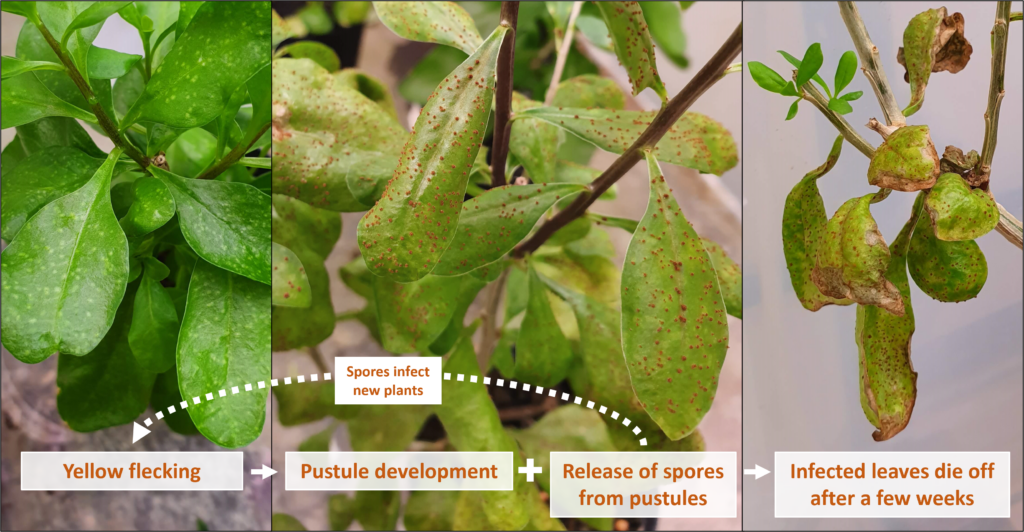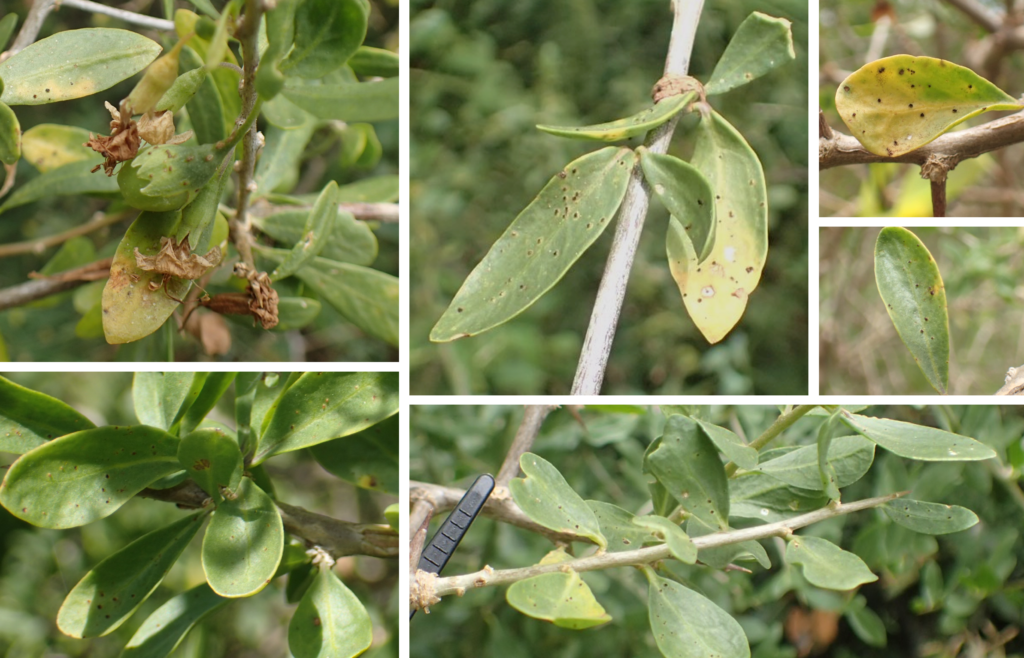Current research (November 2023 – June 2026)
A new project has recently commenced (November 2023) that aims to facilitate the mass-rearing, release, monitoring and evaluation of the impacts of the rust fungus (Puccinia rapipes) for the biological control of African boxthorn (Lycium ferocissimum) across NSW.
This new project is proudly supported by the NSW Government through its Environmental Trust.
Output 1, monitoring and evaluation: The project will enable the establishment of a network of biocontrol agent release sites throughout NSW, in which the performance of the fungus and its effects on the target weed will be monitored regularly over time.
Output 2, community engagement: The project will also deliver the fungus and release instructions to key weed stakeholders across NSW, targeting areas where African boxthorn exerts the greatest threat to biodiversity values. Participants may include, but not limited to, Aboriginal and Torres Strait Islander peoples, biosecurity practitioners (e.g., council weed control officers), volunteer community groups (e.g., Landcare, Bushcare), Rangers (e.g., NPWS), private landholders and other key stakeholders with interests in African boxthorn biocontrol.
This project will include the following main activities:
- Maintain and mass-rear a healthy, viable culture of the biotrophic rust fungus:
- To be achieved under laboratory conditions on healthy, pest-free African boxthorn plants (based at the CSIRO Black Mountain Laboratories in Canberra, ACT).
- Deliver the fungus to registered stakeholders for release into the environment to help control African boxthorn infestations:
- It is proposed that the fungus will be delivered to up to 90 key stakeholders altogether over three years (resulting in release of the fungus at up to 260 sites). All stakeholders with interests in African boxthorn control are eligible to register interested in participating in the project, although there is no guarantee that all parties will receive the fungus if demand for participation is greater than our ability to culture the fungus in the laboratory.
- Establish up to 10 fixed African boxthorn monitoring sites throughout NSW:
- The CSIRO field ecologists will collect baseline weed population data at sites located across a broad climate gradient, with priority given to infestations located in grassy woodland communities in conservation reserves that are most under threat by African boxthorn invasion (especially along creeklines and other water sources).
- Release the fungus at the fixed monitoring sites under optimal climate conditions:
- Releases will preferentially be made during spring 2023, but summer releases will also be considered during periods of high rainfall (or high humidity) under moderate daytime temperatures (< 30°C).
- Monitor the performance of the fungus and its effects on the host African boxthorn plants at the fixed monitoring sites over time:
- The fungus will be released using optimised methods developed by CSIRO researchers. Post-release monitoring will be undertaken once every six months (or at least once per year) to evaluate establishment and spread of the fungus, disease incidence and severity on the host plants, and changes in the cover and condition of African boxthorn foliage in response to fungal infection.

Setting-up a site for monitoring the impact of the biocontrol agent on African boxthorn.
Releasing the biocontrol agent onto African boxthorn
Between November 2023 and June 2026, the CSIRO will provide participants in NSW with a biocontrol agent release kit that contains one or more vials of rust fungal spores. To apply the fungus to African boxthorn plants, participants will mix the dried spores with TWEEN 80 and water in a plastic spray bottle provided. This solution of spores and water will then be misted onto the leaves of the boxthorn plants in the late afternoon, and the treated stem covered with a plastic bag overnight. The fungal spores will germinate in this humid microenvironment and infect the leaves of healthy plants. The plastic bag will then be removed the following morning to prevent the fungus from being killed be elevated temperatures inside the bag when exposed to daylight.
Eligibility to receive the biocontrol agent
The fungus is only available for release in NSW at this stage, as part of this current project supported by the NSW Environmental Trust, up until June 2026. Engagement will be targeted at community and public sector organisations, such as (but not limited to) Landcare, Local Land Services, NSW, Bushcare, local governments, other volunteer groups etc. Private landholders are also eligible to express an interest to participate in the program. The fungus is not commercialisable and cannot be released as part of for-profit ventures, including retail or as part of consultancies.
Please email Caroline Delaisse at boxthornbiocontrol@csiro.au to register your interest to participate in the biocontrol program. The CSIRO will endeavour to respond within one week of receiving the email. As part of the registration, the CSIRO will provide a pre-release assessment document for participants to complete, which requires information about the proposed location of the boxthorn infestation. The pre-release assessment needs to be undertaken prior to receiving the agent.
The biocontrol agent will be provided to registered participants at regular intervals between November 2023 and June 2026. The specific timing of delivery will be determined by prevailing climate conditions, quantity of available material for release and level of demand from registered participants.
The release kit will be sent via post. Participants should release the agent as soon as possible upon receiving their package. However, the spores of the biocontrol agent can be stored in the freezer for one month before preparing the biocontrol agent for release onto African boxthorn plants in the field if conditions at the time of receipt are unsuitable.
Background information on the fungal biocontrol agent, Puccinia rapipes
The biocontrol agent is a biotrophic rust fungus, Puccinia rapipes, that infects the leaves of African boxthorn. It was originally isolated from diseased boxthorn plants in South Africa. Through extensive host-specificity studies undertaken by the CSIRO, the fungus was shown to be highly specific to African boxthorn and other introduced, closely related Lycium species, and poses no danger to native Lycium species and other Australian species. In 2021, the fungus was approved for release into the Australian environment as a biocontrol agent to assist with the control of African boxthorn.
The full data set and comprehensive risk analysis are provided at this link: https://www.agriculture.gov.au/biosecurity-trade/policy/risk-analysis/biological-control-agents/risk-analyses/completed-risk-analyses/puccinia-rapipes

Illustrated life cycle of the rust fungus Puccinia rapipes on Lycium ferocissimum, with putative seasonal timeline.
The rust fungus infects young leaves of African boxthorn, causing yellowing of the leaves followed by the development of pustules. The pustules produce fungal spores which are dispersed by wind. The spores land on the leaves of nearby African boxthorn plants and, under humid conditions, will germinate and infect new leaves. Infected leaves will die back over time. This may result in extensive defoliation of an individual plant if the fungus establishes widely and causes severe disease. Infection by the rust fungus can also disrupt the photosynthetic capacity of the plant, reducing overall plant growth and reproductive output.

Depiction of disease progression for the fungus on Puccinia rapipes

Typical symptoms of infected boxthorn leaves and fruit in the field.
FAQs
Is it safe to release the biocontrol agent into the Australian environment?
In 2017, CSIRO began rigorous evaluation of the risks that the fungus Puccinia rapipes could pose to non-target plants in Australia. Research focused on species within the family Solanaceae. This extensive host-specificity testing was performed in a quarantine facility and involved exposing African boxthorn and non-target plant species to the fungus under optimal conditions for infection. It was found that the fungus is highly specific to African boxthorn (Lycium ferocissimum) and Goji berries (L. barbarum, L. chinense and L. ruthenicum; of which the rust can be easily treated with fungicides already used by goji growers). Based on these research results and following a comprehensive risk assessment process and public consultation, the Federal Department of Agriculture, Water, and the Environment (DAWE) approved the release of the biocontrol agent into the Australian environment. The information package that supported the application to release the agent in Australia, which includes all results, can be found here: https://www.awe.gov.au/biosecurity-trade/policy/risk-analysis/biological-control-agents/risk-analyses/completed-risk-analyses/puccinia-rapipes
What quantity of the biocontrol agent will I receive for release into the environment?
Registered participants will receive via post a “biocontrol agent release kit”. Each biocontrol agent release kit will contain a plastic vial of dried spores collected from pustules produced by the rust fungus. This vial of spores can be used to make a release at one site on a small number of African boxthorn plants. As those plants become infected, the fungus develops pustules which produce spores. Those spores will in turn naturally spread to nearby plants via wind or water and continue the spread of the fungus.
CSIRO staff will work with you to determine the total number of release kits provided, depending on your capacity/interest to release the fungus in your local region. To increase the chances of successful establishment of the fungus, we encourage participants to release the fungus at two points with two separate vials of spores, each separated by at least 200 m. Participants are welcome to request more release kits, but supply is dependent on stock availability.
What effect will the biocontrol agent have on African boxthorn populations? How quickly does the fungus kill African boxthorn?
In the Australian environment, the fungus is not expected to kill African boxthorn. Provided that the biocontrol agent establishes widely and causes severe disease symptoms on African boxthorn, it is expected to reduce the reproductive output and vegetation growth of the weed in the long term. This will in turn reduce its invasion potential in various ecosystems, but will not eradicate it altogether.
How quickly will the fungus spread?
The rate of spread of the fungus will be ascertained by long term monitoring. It is expected that the fungus will spread from one plant to the next very slowly, but the rate of spread will accelerate once the overall abundance of the fungus builds up in the local African boxthorn population. Based on our knowledge of other successful biocontrol agents that have been released previously in Australia, broadscale spread of the fungus would be expected to take several years and will not occur within the first season of release. As such, ‘success’ in the short term for this research project is to first establish the presence of the fungus in the Australian environment.
Can use of the biocontrol agent replace herbicide application or other control methods?
Biocontrol may provide a sustainable, landscape-scale approach for African boxthorn management with no chance of off-target damage to crops or native vegetation. Given that the fungus will not kill African boxthorn altogether, it will complement but not replace the need for other control methods. However, widespread establishment and spread of the fungus may gradually reduce the quantity of chemical herbicide required to suppress weed populations.
What happens if I cannot detect the fungus after release? Has it failed?
It is important to note that the fungus will only infect African boxthorn at high severity under optimal conditions for growth and spread – that is, when warm and moist and the host African boxthorn plants are healthy and vigorous at early stages of growth. As such, we expect that the fungus will not establish in all instances. The fungal spores are delicate and require specific microclimate requirements for germination and infection. The fungus will only become widely established in the Australian environment after many years of sustained releases by various participants.
As such, participants are encouraged to release the fungus on multiple occasions where the initial releases may have failed.
